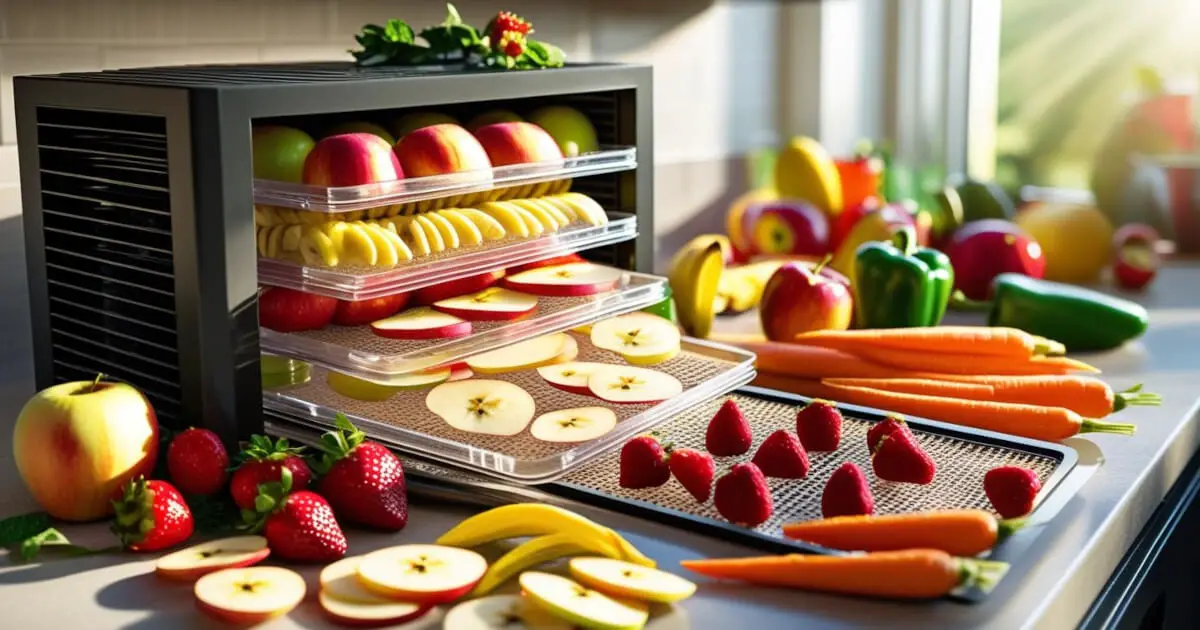
What are the best food dehydrators for fruits and vegetables? To help you choose the right one, let’s first get familiar with dehydration machines, their features, and how they work.
Table of Contents
Dehydration machines, also known as food dehydrators, are appliances used to preserve fruits and vegetables by removing their moisture content. This process extends the shelf life of produce while creating nutritious snacks. Unlike canning, dehydration maintains most of the vitamins and minerals in food without the need for preservatives, making it a healthier alternative.
Types of Dehydration Machines
The market offers a wide variety of dehydration machines, catering to different needs and budgets. These can generally be categorized by size, features, and intended use:
1. Household Dehydrators
Compact and user-friendly, household dehydrators are perfect for personal or small-family use. Many feature adjustable temperature controls and timers, allowing users to customize the drying process for different foods. Popular models, such as Cosori and Presto, are praised for their affordability and ease of use.
2. Commercial Dehydrators
Designed for large-scale operations—such as restaurants, food processing facilities, and small businesses—commercial dehydrators offer high capacity and advanced features. Built with industrial-grade materials, they are durable and efficient. Sites like Alibaba.com showcase a wide selection of commercial units with varying capacities and price points.
3. Specialized Dehydrators
Some dehydrators are made for specific applications, like jerky production, which requires higher temperatures and longer drying times. Others are designed for particular types of produce or feature collapsible trays for convenient storage.
Best Food Dehydrators for Fruits and Vegetables: 5 Key Features
When buying a dehydration machine, keep these important features in mind:
1. Capacity
The capacity of a dehydration machine determines how much produce you can dry in one batch. Machines typically come with stackable trays or shelves, and the number of trays affects how much food you can process at once.
If you only plan to dry small amounts for personal use, a compact unit with 4–6 trays might suffice. But for larger families, gardeners with abundant harvests, or small businesses, a machine with 8–12 trays or expandable options is more practical. Choosing the right capacity helps avoid overcrowding and ensures efficient drying.
2. Temperature Control
Different foods dry best at different temperatures. For example, herbs and leafy greens need lower temperatures to preserve delicate oils and flavors. A dehydrator with adjustable temperature control (typically ranging from 95°F to 165°F or 35°C to 74°C) allows you to set the ideal heat for whatever you’re drying. This flexibility also prevents over-drying and nutrient loss.
3. Timer
A built-in programmable timer is a valuable feature for busy users. Drying can take anywhere from a few hours to more than a day, depending on the food. A timer lets you set the dehydrator and walk away, automatically shutting off the machine or alerting you when the process is done. This prevents accidental over-drying, conserves energy, and gives peace of mind when running the machine overnight or while you’re out.
4. Airflow System
Proper airflow is essential for even dehydration. Some machines use a horizontal airflow system (fan at the back), which distributes heat evenly across all trays, while others use vertical airflow (fan at the top or bottom). Horizontal systems are often preferred for more uniform drying, especially when processing different foods simultaneously. Good airflow also prevents the need to rotate trays constantly, saving time and effort.
5. Ease of Cleaning
Dehydrating sticky fruits like mangoes or pineapples can leave residue on trays, so easy cleaning is a must. Look for machines with dishwasher-safe trays, removable liners, and nonstick surfaces to simplify cleanup. A well-designed dehydrator should allow you to wipe down the main body easily and remove parts without hassle. The easier it is to clean, the more often you’ll use it without dreading the post-drying mess.
Benefits of Using a Dehydration Machine
Dehydrating fruits and vegetables offers several advantages:
1. Extended Shelf Life
Dehydration significantly extends the shelf life of fruits and vegetables by removing the moisture that bacteria, mold, and yeast need to thrive. Without water, these microorganisms cannot grow, which helps prevent spoilage and food waste. Properly dried and stored produce can last for months or even years, making it an excellent option for long-term storage or emergency preparedness and enhances disaster recovery.
2. Nutrient Retention
Unlike some preservation methods like canning or freezing, dehydration preserves most of the vitamins, minerals, and fiber naturally present in fruits and vegetables. While there may be minimal nutrient loss due to heat exposure, the majority of healthy nutrients—such as vitamin A, potassium, and magnesium—remain intact. This makes dehydrated produce a nutrient-dense snack compared to heavily processed options.
3. Convenience
Dried fruits and vegetables are lightweight, portable, and easy to store, making them ideal for on-the-go lifestyles. Campers, hikers, and busy families appreciate that dehydrated foods take up less space in the pantry or backpack. Since they don’t require refrigeration, they’re also perfect for travel, picnics, or emergency kits.
4. Healthy Snacking
Dehydrated fruits and vegetables are naturally sweet or savory, providing a tasty and wholesome alternative to sugary snacks and salty chips. Because they retain most of their natural flavors and nutrients, they can help curb unhealthy cravings while supporting a more balanced diet. Parents also find them a great way to encourage kids to eat more fruits and vegetables in a fun, easy-to-enjoy form.
Conclusion
Dehydration machines are a versatile and efficient way to preserve fruits and vegetables. By selecting the right type and features for your needs, you can enjoy the benefits of home-dehydrated produce—healthy snacks, longer-lasting food, and a more sustainable lifestyle—for years to come.


